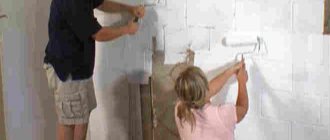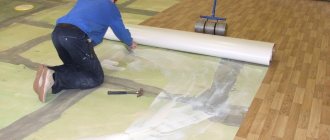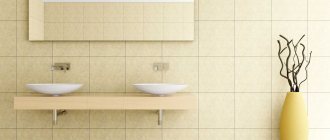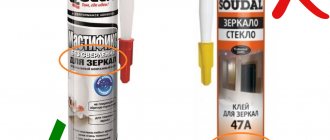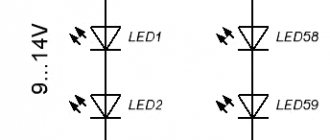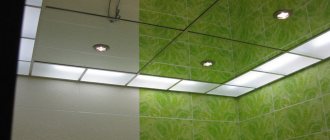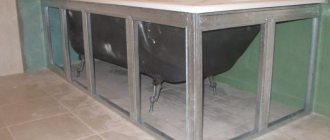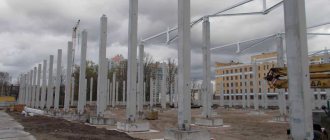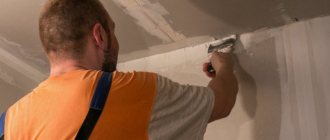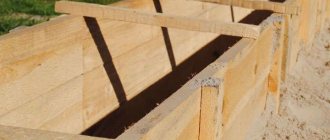Selecting materials
There are several types of concrete plasters:
- Cement-sand mixture. Durable and durable plaster is suitable for rooms with high humidity. It has good thermal conductivity and vapor permeability. Provides reliable sound insulation.
- Gypsum mixture. It is also used for finishing on concrete walls, but it is not suitable for bathrooms, toilets, kitchens, and other rooms with high humidity. Gypsum is more susceptible to mechanical damage.
- Polymer mixtures. These materials are used when it is necessary to eliminate minor defects on a concrete surface. They are not afraid of moisture, have waterproofing and antiseptic properties. Such mixtures are suitable for interior decoration and exterior work. However, such mixtures are used only on an already leveled concrete surface.
Sometimes plastering is carried out with tile adhesive. Its properties are approximately the same as those of cement mortar, but adhesion is higher. However, the composition exhibits noticeable shrinkage, and cracks appear on its surface. It is suitable in cases where the depth of unevenness does not exceed 8 mm. Apply in two layers. The first is up to 6 mm. Then the second one. While the plaster has not set, processing is carried out for leveling. This material can also be used to putty the façade of a building.
Rice. 2. Materials for plastering concrete walls
Another option is gluing using a notched trowel. Applicable only to block concrete surfaces to improve adhesion with subsequent materials.
Preparation of brick surfaces for plastering
New brick surfaces that are hollow (that is, the seams between the bricks are not filled with mortar) are quite rough and therefore there is no need to further incise them.
The preparation of the surface for plaster is such that it is sufficient to simply sweep away the dust from the surface and rinse the surface thoroughly with water; if necessary, be sure to remove contaminants (oil stains, paint, glue, efflorescence). If the seams between the bricks in the masonry are completely filled with mortar, then the preparation of the brick surfaces is such that they will need to be deepened by 0.1-1 cm and treated with a steel brush, dust removed and primed or washed.
How to plaster concrete walls
If you are interested in plastering concrete walls with your own hands, you will need to select the appropriate composition, follow the technology and purchase the following tools:
- spatula, square for applying the solution, ladle;
- bucket and mixer for mixing;
- mesh for reinforcement;
- guide rails used as beacons;
- falcon - a tray with a handle for laying out the solution;
- the rule is a wooden or metal strip for leveling;
- building level;
- float for texture or smoothness.
Is it necessary to install beacons?
You can plaster without beacons. But you can’t do without them if you need to get the ideal geometry of surfaces in a living space and make partitions smooth and even. They are especially important if there are noticeable vertical differences. If the work is carried out in a garage, utility room or other non-residential premises, where aesthetics are secondary, it is enough to disguise noticeable defects, then beacons do not need to be installed.
Lighthouses are:
- plaster;
- from concrete mortar.
A wooden sheathing or a metal profile can be installed. It does not need to be removed once the plaster application is complete.
Preparatory procedures
Preparing the walls begins with removing the old finish - tiles, whitewash, paint or wallpaper. Then the bumps and other bulges are eliminated. Using a suitable tool, you need to roughen the wall. If you plan to lay a cable, channels are made. To do this, use a wall chaser or grinder.
Dust is removed with a jet of water or a damp sponge, then the wall is dried. Once this part of the work surface preparation is completed, a coat of primer is applied. Let it dry and repeat the procedure. Lay the cables in the punched channels. Secure the mesh with dowels.
How to plaster concrete
Rice.
3. Applying a cement-sand mixture to concrete. Concrete should be plastered in this order:
- Preparatory cement spray is the first layer applied with a ladle or trowel. Apply to a damp wall. Recommended thickness – up to 5 mm. The consistency of the mixture is liquid. Excess is removed and the surface is dried. No alignment required.
- Applying a base layer 10 mm thick. You can sprinkle the solution or spread it on. The base is aligned from bottom to top according to the beacons using the rule.
- Covering – front third layer of plaster (2 mm). It fills small pores and scratches left by tools. It is important to achieve a creamy consistency of the mixture. After applying it, the corners are treated, the beacons are removed, and the traces left by them are filled with putty. Alignment is performed by a rule.
- Grouting is the final step necessary to achieve smoothness or texture. It is performed with a grater at the moment when the surface has already set, but has not dried. Movements - circular or running, vertical or horizontal swings.
Before starting work, be sure to sift the sand used to mix the solution. A sieve with cells up to 1.5 mm is used. If you don’t want to make notches on the surface for better adhesion, buy concrete contact primer. It will help save time.
How long does it take for plaster to dry?
Drying time depends on the material and layer thickness. If the plaster of concrete walls is cement-sand 10 mm, after 10 days it gains strength. Cement-lime compositions used when laying the second layer are applied 7 hours after applying the first. Complete hardening occurs within a month. Parameters change with changes in temperature and humidity. The finish will dry fastest in a warm, dry room.
General requirements for plastered wall surfaces
Plastering work with cement mortar can be performed on various surfaces: brick, concrete and wood. For any surface, there are general requirements for preparation for work: the base must be relatively flat horizontally and vertically, sufficiently strong, relatively dry, free of dust, traces of oil, etc. Loose and weak areas on surfaces must be removed and repaired with the same plaster compound (or other material whose strength is not lower than the strength of the base). However, there are some differences, depending on the material from which the structure is made.
Brick, stone, concrete or previously plastered with cement mortar surfaces.
For concrete and plastered surfaces, one of the main requirements is age. The concrete wall must settle and gain strength for at least 3 months, plaster - 28 days. Further stages of work are identical for all surfaces.
The surface is mechanically cleaned of dust and loosely bonded areas of the masonry. For this purpose, hand-held metal or nylon brushes, metal brush attachments for electric drills, and industrial vacuum cleaners are used.
To increase the adhesion of the plaster layer to the surface of the base, masonry mortar is removed from the seams to a depth of at least 10 mm (if brick or stone masonry of the walls is done, knowing that it will be plastered, the seams are not filled with mortar to this depth - such masonry is called empty space). To do this, narrow chisels and a hammer are used, after which the surface is also cleaned of dust.
The linear parameters of the surface are checked; vertical deviations of more than 10 mm are not allowed. Bulges are removed mechanically or manually. To do this, use a power tool (angle grinder, or “grinder”) with a diamond or corundum disk to cut a grid of shallow cuts. Then the convexities are cut off with a chisel and hammer. Concave areas are prepared by applying a layer of plaster (sometimes several layers, reinforced with plaster mesh).
Traces of oils are removed with gasoline or white spirit, then the surface is thoroughly washed with clean water. What you will need: a bucket, hard nylon brushes, rags, sponge.
Brick walls made of fired bricks with a smooth, non-absorbent surface must be primed with CEMMIX Liqui liquid glass in accordance with the instructions for use of the material.
Immediately before starting plastering work, the surface must be moistened. It should be dull damp, but there should be no water stains on it. If there are smudges, they need to be removed with a sponge or rag. This operation is very important to ensure that a dry or highly absorbent surface of the base does not begin to absorb moisture from the plaster mortar, which will lead to a loss of ductility and a decrease in the final strength (it is very difficult to trowel such mortars, and it is impossible to obtain a high-quality surface for further finishing.
Wooden surfaces
Such surfaces have become less and less common lately, but you must be prepared to carry out types of work that will require more thorough preparation of the base. It is most practical to cover wooden structures with sheets of dry plaster, which eliminates “wet” processes when working with wood.
If you decide to plaster wooden surfaces, then preparing the base includes:
- Mechanical cleaning of dust and weakly bonded areas of plaster using hand-held metal or nylon brushes, brush attachments for an electric drill and an industrial vacuum cleaner.
- All exposed wooden surfaces are cleaned of mold, fungi, and lichens, then covered with antiseptics and fire retardants. If there are damaged or rotten wooden elements, they must be replaced.
- To adhere the plaster layer to the wooden base, shingles are stuffed (wooden slats about 20 mm wide, about 5 mm thick), or a plaster mesh is glued on.
- Wetting of surfaces on wooden structures is not required.
Features of outdoor work
Is there a difference in how to plaster a concrete wall inside and outside? Plastering of residential premises inside can be done with gypsum mortar. It is not suitable for the street, as it will not withstand exposure to rain and snow. In the bedroom, living room, and dining room, plaster does an excellent job of leveling. It can be used to finish the ceiling. External work is carried out using heavy cement mixtures that are more resistant to high humidity.
Components are often added to façade mortars to increase plasticity, moisture resistance, and protect against cracking.
Rice. 4. Applying a cement-sand mixture to a concrete façade
Insulation of concrete walls outside
Having decided to plaster the facade, owners often think about its additional protection and insulation. It is important to provide protection from the cold from the outside. It is also important to calculate where the dew point will be. Mineral wool will not work. It absorbs moisture, losing its thermal insulation properties. It is better to use foam boards. If greater strength and durability are required, use extruded polystyrene foam.
Plastering begins with applying glue to the back of the slabs. This is done pointwise around the perimeter. Then the sheet is glued to the wall, starting from the bottom corner. Secure it with umbrella dowels. Install the remaining slabs. Cover the seams between them with polyurethane foam, secure the fiberglass reinforcement mesh, and apply a layer of glue. After it dries, you can plaster it. All that remains is to prime and paint it. Or, as an option, install a ventilated siding facade.
External insulation is carried out only with the installation of slabs in a checkerboard pattern. Seam matching is prohibited.
Preparing wooden surfaces for plastering
On surfaces made of wood materials, a mesh of wooden slats is stuffed - piece or panel shingles, or a metal mesh is mounted.
These materials not only level the surface and make it rough, but also have a reinforcing function.
In addition, the preparation of a wooden surface using new technologies is such that it can include treatment with special compounds that prevent its damage by microorganisms and insects.
Carrying out work manually and mechanically
Plastering walls and ceilings in an apartment by hand is possible, and some craftsmen prefer this method. They believe that this makes it easier to control the process. The mixture used also hardens faster.
However, the duration of work increases significantly. Also, layers often dry unevenly, and creating a solution for different areas of the room with the same consistency is problematic. The task becomes more complicated if the wall area is large.
The machine method allows finishing surfaces of several tens of meters. Also, you don’t have to waste time on mixing and achieving the desired consistency of the solution. All you need to do is throw the components into the plastering station. The method eliminates significant differences in the density of the plaster that you use for concrete surfaces.
Rice. 5. Mechanical plaster
There are other advantages of the mechanized method of applying plaster for concrete bases:
- Versatility. It is suitable for walls and ceilings in residential, office, commercial and industrial areas.
- Affordable price. The price per square meter of mechanical finishing is cheaper than manual finishing.
- No tension in the inner layer. Accordingly, there will be no settlement or cracks.
The mechanized plastering procedure is performed by two performers in the following way. The installation is connected to the network and water supply. It automatically mixes the dry solution with water. Next, beacons are installed and plaster for concrete walls is supplied under pressure through a hose. The second worker levels the surface using a wide rule. After the mixture has dried, final leveling is carried out.
